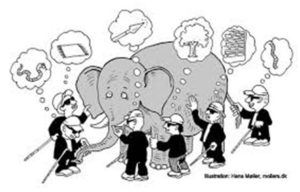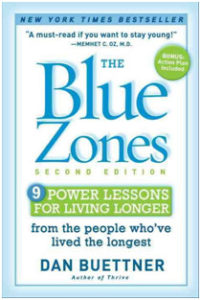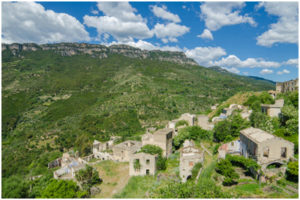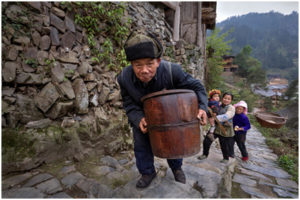Author: Dr. Stephen Chaney
 The diet wars are raging. Everywhere you turn people are arguing about which diet is best. Each diet is based on plausible sounding hypotheses. Each diet has rigid do’s and don’ts. Proponents of these diets are absolutely convinced they have the only answer for a healthy life.
The diet wars are raging. Everywhere you turn people are arguing about which diet is best. Each diet is based on plausible sounding hypotheses. Each diet has rigid do’s and don’ts. Proponents of these diets are absolutely convinced they have the only answer for a healthy life.
You’ve heard the arguments. It is fat that’s killing you. No, it’s the carbs. Saturated fats are bad for you. No, they’re good for you. Coconut oil is bad for you. No, you should eat as much of it as possible. Unsaturated fats are good for you. No, they’re bad for you. The list goes on and on.
It is so confusing. The “experts” arguing over which diet is best can’t all be right…or can they? What if they are like the fable of the 6 blind men grabbing different parts of an elephant and trying to describe  the elephant. Each is describing part of the elephant, but none of them know what the whole elephant is like.
the elephant. Each is describing part of the elephant, but none of them know what the whole elephant is like.
The problem is most diets are based on hypotheses derived from short-term clinical studies. For example, scientists design a clinical study that makes some changes to the diet, and cholesterol levels improve, or blood pressure improves, or markers of inflammation improve. Someone then incorporates those specific changes into their “diet program” and predicts what the health of people following their diet will be 20 or 30 years into the future. They write a book, and another diet fad is launched.
 Those diet authors are like one of the blind men. They have grabbed part of the elephant, and they are trying to predict what the whole elephant looks like based on the part they know. In most cases, they have no idea whether people who follow their diet for 20 or 30 years will be healthy. The long-term data to support their hypotheses simply does not exist.
Those diet authors are like one of the blind men. They have grabbed part of the elephant, and they are trying to predict what the whole elephant looks like based on the part they know. In most cases, they have no idea whether people who follow their diet for 20 or 30 years will be healthy. The long-term data to support their hypotheses simply does not exist.
What if you took the opposite approach? What if you started with the elephant? What if you asked people living healthy, active lives well into their 100s what they ate and how they lived?
Someone has done just that. His name is Dan Buettner. He identified five regions of the world, which he called ”Blue Zones,” where an unusually high percentage of people live into their 100s. He then asked the centenarians in each region about their diet and lifestyle. The results of this remarkable study were published in a book called “The Blue Zones.”
How Was The Study Done?
Dan Buettner is not a scientist. He is a journalist, and his initial “Blue Zone” expeditions were sponsored by National Geographic. However, to his credit he collaborated with the top scientists in the fields of demographics, social anthropology and statistics. In short, he did things right.
The demographers helped him locate the Blue Zones and poured over the birth and death records so they could prove beyond a shadow of a doubt these were regions where an extraordinary percentage of people lived to 100 and beyond. The social anthropologists helped him design the questionnaires and interview the centenarians. The statisticians helped him analyze the data.
 The Blue Zones were very diverse. They consisted of:
The Blue Zones were very diverse. They consisted of:
- A mountainous municipality on the Island of Sardinia off the coast of Italy.
- Rural villages on the Island of Okinawa.
- The 7th Day Adventist community in Loma Linda, California.
- Some remote villages in Costa Rica
- A small island called Ikaria off the coast of Greece.
Many of these locations are remote, but the 7th Day Adventist community lives in the heavily populated Los Angeles basin. In his book, Dan Buettner describes getting off the freeway and driving past all the usual fast food restaurants on his way to interview the 7th Day Adventist centenarians, who obviously never ate at those restaurants.
The people in each of these regions followed a lifestyle that was dramatically different from people in surrounding communities. In the case of the 7th Day Adventists, their lifestyle was based on their religious teachings. People in the other regions were simply following traditions passed down over many generations.
It is fascinating to read about each of these Blue Zone communities. There were some significant differences in the foods they ate and the way they lived their lives. However, Dan Buettner and his scientific collaborators were not interested in the differences. They were interested in the similarities.
The similarities were striking. More importantly, they tell us a lot about the kind of diet and lifestyle that is associated with health and longevity. This isn’t hypothetical health and longevity based on some short-term clinical studies. This is real life health and longevity based on people who have actually lived it.
What Do Blue Zones Tell Us About Longevity?
 Here are the common characteristics of every Blue Zone studied. I call them “the secrets of the centenarians.”
Here are the common characteristics of every Blue Zone studied. I call them “the secrets of the centenarians.”
#1: They engage in moderate intensity exercise every day. None of them run marathons or engage in high intensity workouts in the gym. Some are shepherds. Others tend their farms. The 7th Day Adventists take nature walks. Exercise isn’t planned. It is part of their daily life.
#2: They stop eating before they are full. As a child, I remember a TV add in which the actor would say “I can’t believe I ate the whole thing” before plopping two Alka-Seltzers in a glass of water. The long-living people in Blue Zones don’t do that. They stop eating when they are no longer hungry, not when they are full. Okinawans call it hara hachi bu, which roughly translates into stopping when their stomachs are 80% full. That simple practice cuts calories by 20% and dramatically reduces the incidence of obesity.
#3: They eat a mostly plant-based diet. They eat mostly fruits, vegetables and whole grains. Nuts also play an important role in their diet. Beans are the major protein source. They avoid processed foods and seldom eat meat. Strict 7th Day Adventists avoid meat entirely. The other Blue Zone populations ate meat primarily on special occasions. When they did eat meat, it was often pork or lamb. Based on the data from these Blue Zone populations, Dan Buettner recommends eating meat no more than twice a week, with each serving being the size of a deck of cards.
#4: They have a libation with their meals. For the Sardinians, it was red wine. For the Okinawans, it was sake. The key is moderation. No more than a glass or two. If you don’t drink, that’s fine too.
#5: They have a purpose in their lives. They have a reason to live. It can be service to others. It can be a hobby. It can be a quest for learning something new. Whatever it is, they have something to look forward to every day.
#6: They set aside time for relaxation. They have a time set aside each day to relax with friends or family and de-stress. This improves their mental outlook and reduces their risk of disease.
 #7: They participate in a spiritual community. The religions were different in each Blue Zone, but they all belonged to strong religious communities. As Dan Buettner put it: “The simple act of worship is one of those subtly powerful habits that seems to improve your chances of having more good years.”
#7: They participate in a spiritual community. The religions were different in each Blue Zone, but they all belonged to strong religious communities. As Dan Buettner put it: “The simple act of worship is one of those subtly powerful habits that seems to improve your chances of having more good years.”
#8: They put family first. They build their lives around their families, and when they become old their families take care of them.
#9: They surround themselves with communities that share their values. These social networks provide support, encouragement, and happiness.
As you read through the 9 things that these Blue Zone communities have in common, your first reaction may be one of dismay. In today’s world, it is exceedingly difficult to achieve all 9 elements of a centenarian lifestyle. Just be comforted with the thought that the more of these 9 elements you can incorporate into your personal “Blue Zone,” the healthier you will be and the longer you will live.
What Do Blue Zones Tell Us About Diet?
If you have been trying to figure out what kind of diet is best for you, the biggest take home lesson from “The Blue Zones” is that you can forget all the absolutes you have heard from the proponents of various diet plans. For example:
- All the Blue Zone communities included whole grains, legumes, and starchy vegetables as part of their diet. You don’t have follow a low carb diet to live to 100.
- While all the Blue Zone communities ate a plant-based diet, most included some meat in their diet. You don’t have to go meatless to live to 100.
- Some of the Blue Zone communities ate pork and lamb as their main meat. If you eat meats sparingly as part of a mostly plant-based diet, you can eat red meat and still live to 100.
- Only two of the five Blue Zones were in the Mediterranean region. You don’t have to follow a Mediterranean diet to live to 100.
In short, the proponents of today’s popular diet plans are indeed like the 6 blind men trying to describe an elephant. When you see the entire elephant, it looks a lot different.
The Bottom Line
- In his book “The Blue Zones,” Dan Buettner described five regions of the world where an exceptionally high proportion of people are living healthy, active lives well into their 100s. He teamed with a group of scientists to find out what they eat and how they live.
- Here are the 9 common characteristics of every Blue Zone Community he studied:
- They engage in moderate intensity exercise every day.
- They stop eating before they are full.
- They eat a mostly plant-based diet.
- They have a libation with their meals.
- They have a purpose in their lives.
- They set aside time for relaxation.
- They participate in a spiritual community.
- They put family first.
- They surround themselves with communities that share their values.
- As you read through 9 things the Blue Zone communities have in common, your first reaction might be one of dismay. In today’s world, it is exceedingly difficult to achieve all 9 elements of a centenarian lifestyle. Just be comforted with the thought that the more of these 9 elements you can incorporate into your personal “Blue Zone,” the healthier you will be and the longer you will live.
- When you look at what people in Blue Zone communities eat, the biggest take home lesson is that you can forget all the absolutes you have heard from the proponents of various popular diet plans. For example:
- All the Blue Zone communities included whole grains, legumes, and starchy vegetables as part of their diet. You don’t have follow a low carb diet to live to 100.
- While all the Blue Zone communities ate a plant-based diet, most included some meat in their diet. You don’t have to go meatless to live to 100.
- Some of the Blue Zone communities ate pork and lamb as their main meat. If you eat meats sparingly as part of a mostly plant-based diet, you can eat red meat and still live to 100.
- Only two of the five Blue Zones were in the Mediterranean region. You don’t have to follow a Mediterranean diet to live to 100.
- For details, read the article above.
These statements have not been evaluated by the Food and Drug Administration. This information is not intended to diagnose, treat, cure or prevent any disease.
